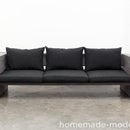Introduction: HomeMade Modern DIY Concrete Nesting Tables
I made these concrete nesting tables using nothing but Quikrete and LEGO bricks. I love how these concrete tables show the texture from the LEGO. I was skeptical about how well this idea would work, but everything went smoothly and Lego formed concrete is my new obsession.
Step 1: Supplies + Tools
LEGO Bricks
Available at Amazon
I used the classic LEGO bricks to make the mold. I raided my parent's attic to retrieve my childhood stash and purchased a few new sets. Purchasing all new bricks for this project might be a bit expensive, so I'm working on a post showing how the nightstand could be cast in sections to reduce the amount of LEGO needed.
3/4" Melamine Board
Available at the Home Depot
Melamine board is particle board with a smooth laminate surface. It's a great product for making a concrete form work. I bought a 4' by 4' sheet and had four 2 1/2" strips cut at Home Depot.
Quikrete Countertop Mix
Available at the Home Depot
I prefer the Commercial Grade Quikrete Countertop Mix for these type of projects but Quikrete 5000 will work just fine as well.
Hot Glue Gun
Available at the Home Depot
I used a hot glue gun to glue the LEGO bricks to the board. Don’t worry – the glue will peel off later.
Step 2: Layout the Mold
Step 3: Mix + Pour the Concrete
Step 4: Level + Smooth
Step 5: Let the Concrete Cure
Step 6: Remove the Mold
Step 7: Clean the Legos
Step 8: Finished (+Bonus Project)!
Good luck making your own concrete nesting tables and please email or tweet photos to @benuyeda or ben@homemade-modern.com. For more DIY ideas and projects, visit us as HomeMade Modern.
BONUS PROJECT!
8-bit video games and LEGO remind me of my childhood. This mini project was an experiment in making molds for concrete inspired by 8-bit graphics.
Get Complete Visual Step-by-Step Instructions at Stellar.






